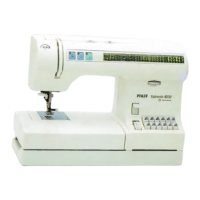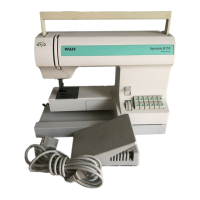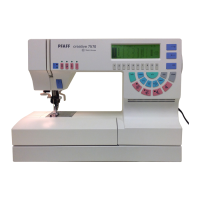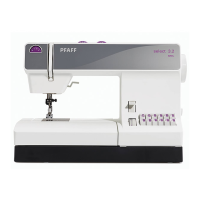e
a
'""
....,
iii
~
c:
iii
~
iii
I!I
n::
A
~
VoN
...--
~
prog
I
-
.....
-
~
v
la
G 2.5 0
0
5
Cording
Ib
G
2.5
0
-
5
foot
Cording foot
The classic sewing technique
of
cording can
be used
without
any problems on fabrics such
as
cotton and
light
wollens. Underclothing and
children's wear can be given a traditional
look
with
cording.
- Engage the cording foot.
- Replace the
needle
with
a
twin
needle
(1.6
or
2 mm).
- Thread up
with
two
needle threads (see
page 64).
-
Now
set the needle thread tension
quite
tight
(at about 5),
to
make
the
seam more
prominent.
TIP: If you wish
to
emphasize
the
cording
effect, you can
fit
a
"cording
tongue"
on
the
front
edge
of
the
needle plate. This shapes
the
fabric during sewing and gives
the
cording
more volume.
78
You can obtain a
similar
effect
by using a
gimp
thread;
this
makes
the
cording look
wider.
In
this
case, however, do
not
use a cording
tongue.
- To
do
this, remove
the
needle plate.
- Thread
the
gimp
thread
through
the
hole
of
the
needle plate
from
below
to
the
top.
- Replace
the
needle plate. The notch
bet-
ween the needle plate and
the
sewing
machine provides space
for
the
gimp
thread. This thread
must
be fed
under
the
cloth plate, so
that
it
does not become
tan-
gled during sewing.
-
While
sewing
the
cording
pull
the
material
lightly.
- You can use
the
grooves in
the
cording
foot
to
guide
the
work
along an already sewn
cording seam. This ensures
that
the
distance between cording seams
is
always
constant.
TIP: There are
two
different
cording feet:
a five-groove and a seven-groove
foot
(see table on page
76).
With
the
seven-groove
foot
the
sewn cordings
are
closer
together
than
with
the
five-groove
foot.
